Search Results

- IDNO:
- 041185
- Title:
- Civilian Medical Worker and Armed Soldier in Germany
- Date:
- ca. 1945
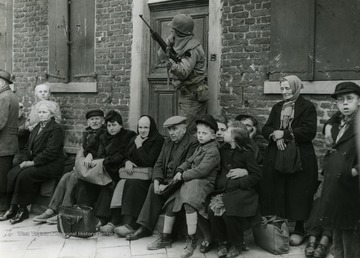
- IDNO:
- 041188
- Title:
- Civilians of Captured German Town, Neuss, Germany
- Date:
- ca. 1945
- Description:
- Information on back of photo reads: "German civilians sit with their children outside of a house in a Reich town captured by troops of the Ninth U.S. Army advancing to the Rhine River. The civilians have been lined up for questioning by an American officer. Units of the Ninth Army reached the Rhine March 2, 1945, when they captured Neuss opposite the industrial center of Dusseldorf."
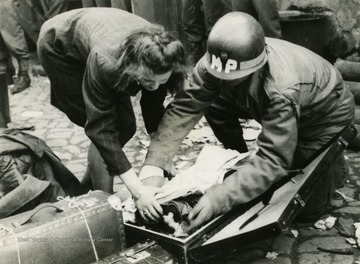
- IDNO:
- 041189
- Title:
- German WAC Captured, Germany
- Date:
- ca. 1945
- Description:
- Information on back of photo reads: "Private Thomas H. Olsen of Chicago, Illinois, checks over the baggage brought by one of the German Army women to the prisoner-of-war enclosure of the 83rd Infantry Division, Ninth U.S. Army. The women surrendered after receiving leaflets. Supreme Headquarters Allied Expeditionary Force reported May 1, 1945, that nearly three million German prisoners had been taken by the Allies in the West since "D-Day" (June 6, 1945)."
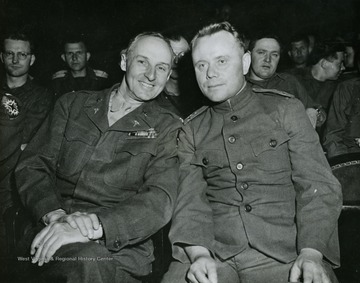
- IDNO:
- 041190
- Title:
- Allied Officers Attend Show Given By Freed Russians, Lippstadt, Germany
- Date:
- ca. 1945
- Description:
- Information on back of photo reads: "Colonel H.A. Forlong (left) of Pontiac, Michigan, Surgeon of the 18th Corps, Ninth U.S. Army, sits beside a Russian Army officer at a stage show given in Lippstadt, Germany, May 20, 1945, by liberated Russian soldiers and former slave workers. Lippstadt is 70 miles northwest of the Rhine River city of Duisburg.
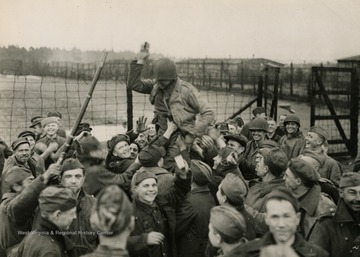
- IDNO:
- 041191
- Title:
- Russian Prisoners of War Liberated By Advancing U.S. Troops
- Date:
- ca. 1945
- Description:
- Information on back of photo reads: "Liberated Russians cluster around a Ninth U.S. Army soldier, carried high on their shoulders, for cigarettes, which they had not seen in many months. When the American finally convinced the Russians that he had no more, they "chaired" him and carried him around the yard before their former prison, the Nazi Stalag 326, south of Bielefeld. The first U.S. troops reached Stalag 326 April 2, 1945. Nine thousand Russian prisoners of war were liberated but thousands were at the point of starvation. Tubercular patients numbered 1,350. in vast mounds all around the camp, 30,000 Russians, most of them starved to death, were buried in heaps of 500. Major Gregory Matviev, who was captured in Sebastopol in 1942, reported that hundreds died daily of starvation and "about 50 were shot every other day for no reason at all.""
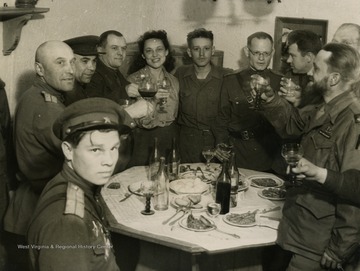
- IDNO:
- 041192
- Title:
- U.S. Troops Meet Russians in Torgau, Germany
- Date:
- ca. 1945
- Description:
- Information on back of photo reads: "Russians and Americans toasting each other after the link up at Torgau. Ann Stringer, U.P. Correspondent can be seen in the picture. Also man with beard on right, who is Correspondent Jack Thompson, of Chicago Tribune."
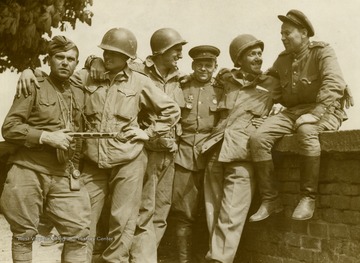
- IDNO:
- 041194
- Title:
- U.S. and Red Armies Link Up, Torgau, Germany
- Date:
- ca. 1945
- Description:
- Information on back of photo reads: "Firm contact has been established between ground forces of the First American Army and those of the Russian Army. The historic meeting took place in the town of Torgau, on the Elbe River, 75 miles south of Berlin, when First Army troops met forward elements of the Russian Guards Division."
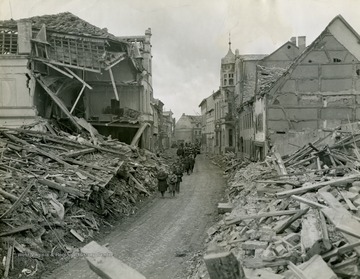
- IDNO:
- 041196
- Title:
- German Civilians March Through Newly Captured Zulpich, Germany
- Date:
- ca. 1945
- Description:
- Information on back of photo reads: "German civilians march through newly captured Zulpich, Germany, to receive instructions on their conduct from military government unit with 9th Infantry Division of 1st U.S. Army. Town was hard hit by U.S. bombers blasting path to Rhine."
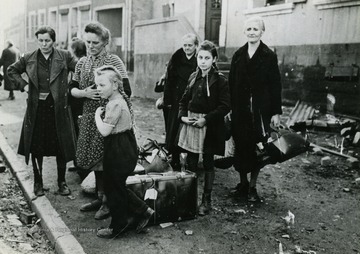
- IDNO:
- 041197
- Title:
- German Civilians Evacuated From Battle Area, Schaffhausen, Germany
- Date:
- ca. 1945
- Description:
- Information on back of photo reads: "German civilians are rounded up for evacuation from Schaffhausen, occupied by Seventh U.S. Army troops March 14, 1945. The German town, six miles north of the frontier of Alsace, is under constant enemy shellfire."
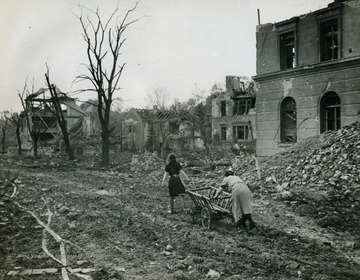
- IDNO:
- 041198
- Title:
- German Refugees Move Through Ruins of Regensburg, Germany
- Date:
- ca. 1945
- Description:
- Information on back of photo reads: "German refugees with a cart move through the ruins of bombed Regensburg, captured by the 65th Division of the Third U.S. Army April 23, 1945. General George Patton's Third Army struck into the Southern German segment from the northwest to capture the Danube River town, which is about 70 miles from Munich."
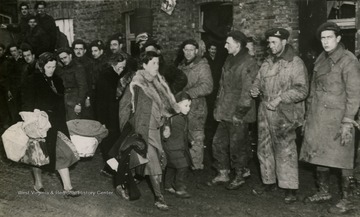
- IDNO:
- 041199
- Title:
- Humiliated German Women Pass Through Canadian Lines to Evacuation Center
- Date:
- ca. 1945
- Description:
- Information on back of photo reads: "Shame, guilt, and humiliation cloud the faces of these German women as they pass through the Canadian lines to an evacuation centre. They put guns before butter in the years between the wars; they lived on the loot of conquered Europe, and clothed themselves in furs from Russia and fine clothes from Paris. Now it is their turn to be homeless, and the watching troops, who saw grim evidence of German ruthlessness in the countries they liberated, show no sympathy."
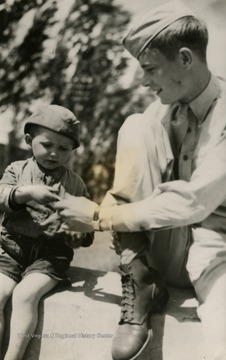
- IDNO:
- 041200
- Title:
- U.S. Soldier Introduced Russian Lad to Chewing Gum
- Date:
- ca. 1945
- Description:
- Information on back of the photo reads: "Puzzled but curious, a little Russian boy accepts a stick of chewing gum from his new friend, a U.S. Air Forces solider at the Russian terminus of Italy-Russia shuttle missions flown by heavy bombers of the U.S. Fifteenth Army Air Force. Since June, 1944, Allied bombers from England and Italy, escorted by fighters, have flown to bases in Russia, and return, attacking enemy targets in occupied Europe en route."











